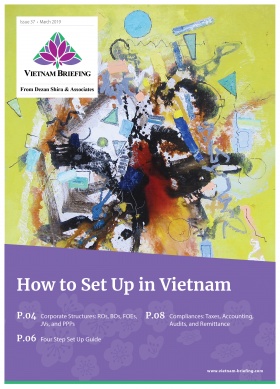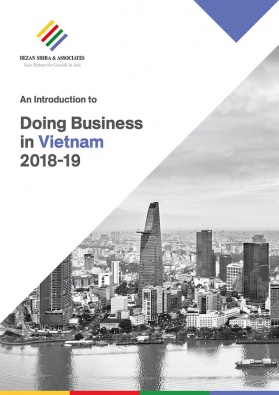Remitting Profits in Vietnam: A Step by Step Guide
Once a company makes a profit and is able to meet the basic requirements for remittance, as mentioned in our introductory article, challenges will remain with respect to ensuring that the remittance process goes smoothly.
Whether it be a decision over the method of repatriation or when to take profits, the ways in which investors choose to approach the remittance process can have a significant impact on the quantity and timeframe under which profits will be accessible.
Step 1 – Set up a foreign currency bank account
When entering the Vietnamese market, foreign investors who wish to remit profits to their home markets will be required to open a foreign currency bank account. This account is to be utilized for all foreign currency transactions carried out within the country. For FDI activities in Vietnam, investors will are required to open a Direct Investment Capital Account (DICA) or an Indirect Investment Capital Account (IICA).
Actions requiring foreign currency accounts
Specific transactions requiring the use of a foreign currency bank account include:
- Receipt of charter capital;
- Increased capital expenditure in which the funding of such expenditure originates in third party countries;
- Receipt of financing via loans from foreign sources;
- Disbursement of loan payments to third parties outside of Vietnam (inclusive of interest); and
- Disbursement of dividends and other profits to shareholders, the origins of which have been derived from Vietnam based operations.
For companies that have already established operations in Vietnam, foreign currency accounts will have been set up during the transfer of funds to capitalize on given projects.
Alternatively, those considering Vietnam as a destination for future investment should note that, while the use of foreign bank accounts is important at the latter stage of the remittance process, it is nonetheless crucial to finalize banking arrangements on the front end of the investment. Not only will this be necessary to start operations within the country, but it also ensures that remittances can be carried out in a seamless manner.
Restrictions
When selecting and operating a foreign currency account, investors are faced with a number of restrictions. The following are some of the most pressing issues that investors should prepare for when opening foreign currency account
Institutional selection
When opening a foreign currency account, investors are limited to the selection of a single account with a bank that has been licensed by the SBV. In practice, the only banks that will be able to operate foreign currency accounts for investors are those with this license. While limiting the selection of institutions, a number of large international banks such as Standard Chartered and HSBC are able to host foreign accounts. Individual banks should be contacted to ascertain their status with a Vietnamese official.
Currency limitations
When opening foreign currency accounts, investors must select the account’s denomination. At present, foreign firms are limited to one foreign currency account in a single currency. Exceptions to this rule may be made if investors can prove that the denomination of their overseas loans differ from the currency utilized in funding Foreign Direct Investment (FDI) projects within the country.
Switching banks
Pursuant to the aforementioned limitations on foreign accounts, those seeking to switch banks may be required to close existing accounts prior to establishing relations with new financial institutions. In the event that this course of action is taken, the closure of accounts must be conducted in compliance with procedures outlined by respective banks.
Requisite documentation
Upon the selection of a government-approved bank, the following documentation should be prepared to open the foreign currency account. It should be noted that the specific requirements of banks may vary and that requirements may differ depending on the nature of FDI projects within the country (i.e. 100 percent Foreign Owned Enterprise vs Joint Venture).
Step 2 – Settle all tax obligations
According to guidance documents issued by the Ministry of Finance, companies remitting profits from Vietnam must have fulfilled all obligations to government authorities prior to remitting. On an annual basis, the issue of greatest importance in this respect is that of taxation. Most investors will be subject to Corporate Income Tax (CIT), Value Added Tax (VAT) and Special Consumption Tax (SCT). Paying these on time will ensure that profits can be remitted freely.
Corporate Income Tax
The standard CIT rate for all enterprises in Vietnam, both local and foreign is 20 percent.
It should be noted, however, that investment in the following industries will be subject to higher rates of taxation:
- Seeking, exploring, and exploiting petroleum and gas deposits is subject to a CIT rate of 32 to 50 percent; and
- Seeking, exploring, and exploiting rare minerals such as silver, gold, and gemstones is subject to a CIT rate of 40 or 50 percent.
Value Added Tax
VAT is imposed on the supply of goods and services at three different rates: zero percent, five percent and 10 percent (the standard rate). For goods and services purchased from abroad, VAT applies to the duty paid value of imported goods and services. The importer must pay VAT at the same time that they pay import duties to customs. For some categories of goods and services, which are subject to special consumption tax, VAT applies to the selling price plus the special consumption tax.
Special Consumption Tax
Special consumption tax is a form of excise tax that applies to the production or importation of specific foods and to certain services. Depending on the good in question, taxes levied on production can range from 10 to 75 percent. It is important that companies consult with relevant government bodies prior to investment to ascertain if they will be faced with SCT and the rate at which SCT will be applied.
Social insurance
Outlined under personal income tax legislation, social insurance contribution in Vietnam covers compensation for salary lost due to illness, maternity, work accidents, occupational diseases, retirement, and death. As of 2019, the total mandatory employer contribution to the social, health, and unemployment insurance funds stands at 21.5 percent of an employee’s monthly wage.
Payment
Enterprises must pay tax in the localities where they are headquartered in. For an enterprise that has a dependent cost-accounting production establishment (including a processing and assembly establishment) operating in a province or city other than where it is headquartered, the tax amount shall be calculated and paid in both the locality where the enterprise is headquartered and the locality where its production establishment is based.
The amount of CIT payable to the province or city where a dependent cost-accounting production establishment is based is the payable CIT amount in a period multiplied by the ratio between expenses incurred by the production establishment and the total expenses incurred by the enterprise.
Step 3 – Audit and compliance
Following successful payment of taxes, companies operating within Vietnam will be required to submit tax finalization statements. Not only will these allow government officials to see that the company in question has fulfilled its obligations to the Vietnamese state, but it will also allow for the company to prove that it turned a profit during the year – thus complying with Vietnamese remittance standards.
Requisite documentation
In preparation for annual audit and compliance, companies should prepare the following documentation in accordance with up to date Vietnamese Accounting Standards:
- Form No. 04-CS/SXK Report on Production and Business Activities;
- Form No. 04-CD/GVGL Report on Charter Capital Contribution;
- Form No. 03/TNDN CIT Finalization Statement;
- Form No. 05/KK-TNCN PIT Finalization Statement;
- Form No. 05A/KK-TNCN List of income and deductions of resident employees; and
- Form No. 05B/KK-TNCN List of Income and deductions of non-resident and temporary employees.
While completion of an annual audit is important from a compliance perspective, the requirement to present audited financial statements prior to remittances results in a limited window during which profits may be repatriated. In conjunction with restrictions limiting outward remittances to once per annum, the due date for annual financial statements in March is likely to dictate the timeframe during which remittances may be carried out.
Step 4 – Withholdings taxation
Prior to remitting profits, investors may be faced with additional taxes determined by their method of remittance. Referred to as withholdings taxation, these taxes are taken by the Vietnamese government as a percentage of the remittance in question.
Currently, remittances are segmented into the following four categories – each of which is subject to a differing rate of taxation:
Dividends
No tax is currently imposed on dividends remitted overseas unless paid to individuals – who are then subject to a five percent withholding tax unless the rate is reduced under a tax treaty.
Interest
Interest paid to a non-resident is subject to a five percent withholding tax unless the rate is reduced under a tax treaty.
Royalties
Royalties paid to a non-resident are subject to a 10 percent withholding tax unless the rate is reduced under a tax treaty.
Technical service fees
A withholding tax of five percent (corporate tax) and five percent (VAT) generally applies to technical service fees paid to a non-resident. The corporate tax may be exempt under a tax treaty.
Step 5 – Foreign exchange
Profit generated by the majority of companies operating in Vietnam will be denominated in Vietnamese Dong (VND). While funds may remain in VND denominated accounts during the duration of their stay within the country, the remittance process requires funds to be transferred into foreign currency accounts, as mentioned earlier.
The transfer of funds into foreign denominated accounts will thus entail the conversion of funds into the currency of the respective account. Unlike the floating exchange rates found in many investors’ home countries, Vietnam employs a fixed exchange rate with a band of one percent available to individual banks. This results in three rates of exchange that companies should take note of when assessing remittances from Vietnam:
- Vietnam’s Official Exchange Rate: issued regularly by the SBV, this dictates the rate at which the Vietnamese government will buy and sell currency. The most recent rate of exchange issued by the SBV was on October 2 at a rate of 23,163 VND per USD.
- Banking Rates: set by individual banks, these rates are required to be within a one percentage point band of the rate set by the Vietnamese government. Thus, a significant consideration for companies should surround the ways that individual banks choose to set rates.
- International Floating Rate: as a point of reference, companies should also take note of the differential between the international rate of exchange found outside of Vietnam and those rates employed within Vietnam. In the case that the differential is significant, companies may choose to hold off on remitting profits until such a time when the differential is lowered.
Step 6 – Notification of relevant offices
Following the declaration of corporate income tax and issuance of audited financial statements, the company must report its intention to repatriate profits to the tax bureau. If within seven days, there is no notice from the tax bureau, the profits may be remitted out. The location of a given investment project will dictate the office with which the notification process must be coordinated.
About Us
Vietnam Briefing is produced by Dezan Shira & Associates. The firm assists foreign investors throughout Asia from offices across the world, including in Hanoi and Ho Chi Minh City. Readers may write to vietnam@dezshira.com for more support on doing business in Vietnam.
- Previous Article Remitting Profits from Vietnam: An Introduction for Foreign Investors
- Next Article Mergers and Acquisitions in Vietnam – Latest Issue of Vietnam Briefing Magazine







